PDF chapter test TRY NOW
Some hormones control the growth of all bodily tissues, regulates sperm production in men, stimulates ovulation in females, regulates milk secretion after delivery, regulates the amount of water in the blood, etc.
Do you know the secretion of these hormones is controlled by a single gland present at the middle of the skull base? Since this gland controls many of the other endocrine glands, it is called the master gland. The name of the gland is pituitary.
Important!
The ectoderm of the embryodevelops the pituitary gland. The pituitary gland is located in the middle of the skull base, in a bony structure called sella tursica.
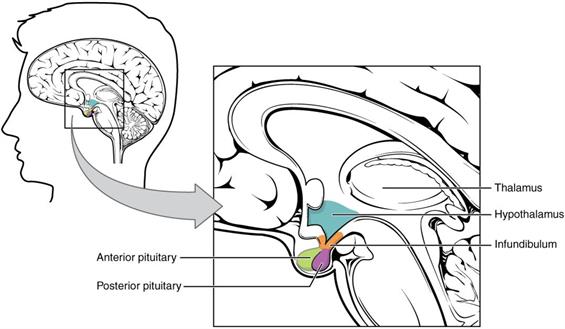
Location of pituitary gland
It is attached to the hypothalamus by a stalk called the infundibulum. It's behind the nose, just beneath the hypothalamus, a portion of the forebrain. Its approximate weight in an average adult human being is \(0.5\) g.
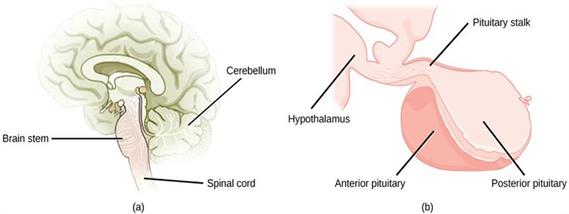
Pituitary stalk attached with hypothalamus
Anatomically, the pituitary gland is divided into two hypophyses.
- Adenohypophysis (Anterior lobe)
- Neurohypophysis (Posterior lobe)
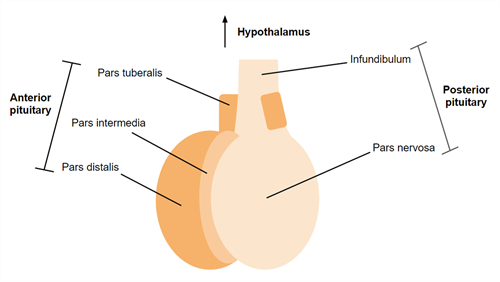
Anterior and posterior pituitary
- The anterior parts of the front lobe or Pars distalis and the middle lobe or Pars intermedia are the two parts of the adenohypophysis.
- The posterior lobe or Pars nervosa is a part of the neurohypophysis.
- Pars tuberalis
- The Pars tuberalis of the anterior lobe is highly vascularized and wraps around the pituitary stalk.
A. Hormones of the anterior lobe
The pituitary glands anterior lobe secretes the following hormones, the majority of which are trophic hormones.
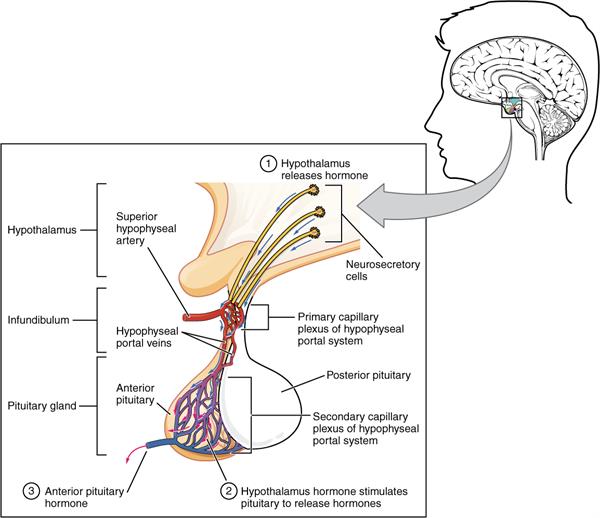
Structure of adenohypophysis - To stimulate this part, hypothalamus secretes separately and reaches to the anterior part by hypophyseal portal system.
Thyroid-stimulating hormone (TSH):
- Thyrotropin-releasing factor, generated by the hypothalamus, regulates \(TSH\) secretion.
- Stimulates thyroid gland to generate thyroxine hormone.
- Hyposecretion causes thyroid atrophy, which leads to thyroid gland destruction.
Somatotropic or growth hormone (\(STH\ \)or \(GH\)): STH hormone stimulates the growth of all bodily tissues, including bones and controls the metabolism of cells.
Adrenocorticotropic hormone (\(ACTH\)): \(ACTH\) stimulates the adrenal cortex to release glucocorticoid and mineralocorticoid hormones.
Follicle-stimulating hormone (\(FSH\)):
- FSH increases the formation of the Graafian follicle and the release of oestrogen hormone in females.
- FSH is a hormone that regulates sperm production in men.
Luteinizing hormone (\(LH\)):
- LH stimulates ovulation in females by stimulating the formation of the corpus luteum and the release of progesterone hormone.
- LH is known as Interstitial Cell Stimulating Hormone (\(ICSH\)), which stimulates testosterone secretion in males.
Prolactin:
- It is a hormone that regulates breast enlargement during pregnancy.
- After delivery, it regulates milk secretion.
B. Hormone of the intermediate lobe
The pituitary gland's intermediate lobe secretes a hormone called melanocyte-stimulating hormone (\(MSH\)). It stimulates the production of the black pigment called melanin when UV light is exposed. This hormone is responsible for the dark colour of the skin.C. Hormones of the posterior lobe
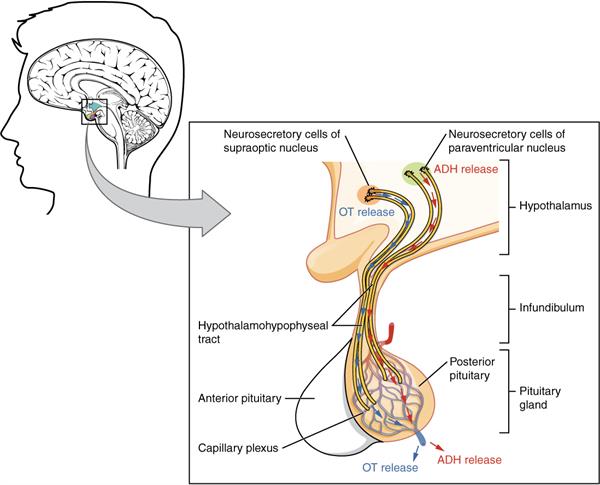
Posterior pituitary gland and release of oxytocin and ADH
Neuroectoderm is the source of posterior lobe hormones. Pituitrin is a hormone secreted by the posterior lobe that contains two hormones.
Oxytocin:
- During parturition (the process of delivering the baby), oxytocin causes the uterine muscles to contract.
- During breastfeeding also aids in the release of milk in the female breasts. Hence it is also called as " Milk ejecting hormone".
Antidiuretic hormone (\(ADH\)) or vasopressin:
- Vasopressin regulates the amount of water in the blood, which ensures a balance of electrolyte concentrations.
- Blood arteries are contracted, which raises blood pressure.
In reality, the posterior lobe of the pituitary gland does not secrete any hormones; instead, the hypothalamus secretes these hormones. The pituitary gland is often known as the body's "Master Endocrine Gland" or the "Chief Executive of the Endocrine System" because it secretes several hormones (such as \(TSH\), \(ACTH\), and others) that regulate the functioning of other endocrine glands.
The pituitary gland is not correctly referred to be a master endocrine gland because it is controlled by releasing hormones secreted by the brain's hypothalamus. Hence, the hypothalamus is the endocrine regulator's supreme commander.
The video explaining the functions of hypothalamus and pituitary gland.
The following are examples of pituitary gland disorders.
Pituitary Dwarfism
A lack of growth hormone in childhood causes dwarfism, which is characterised by short stature and slowed bone and organ growth.

A person affected by dwarfism
Gigantism
Gigantism is a condition caused by excessive growth hormone release throughout childhood. Bones stretch beyond their natural limits, resulting in extremely long heights.
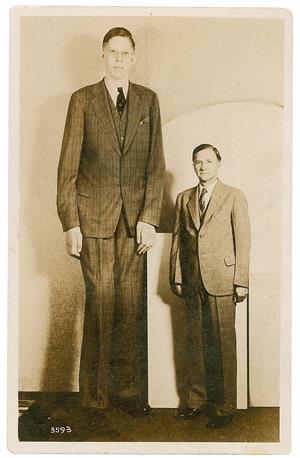
A person affected by gigantism
Acromegaly
Acromegaly is a condition caused by an adult's overproduction of growth hormone. It's characterised by an abnormal increase in the size of the bones in the face and limbs.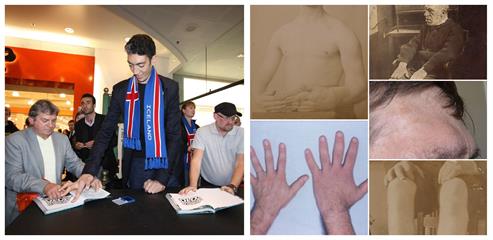
Left to right: Sultan Kosen & other persons are affected with acromegaly
Diabetes insipidus
Diabetes insipidus is a kind of diabetic disease that affects the kidneys. It is caused by an \(ADH\) (Antidiuretic hormone) deficit. It is characterised by the excretion of large amounts of dilute urine.
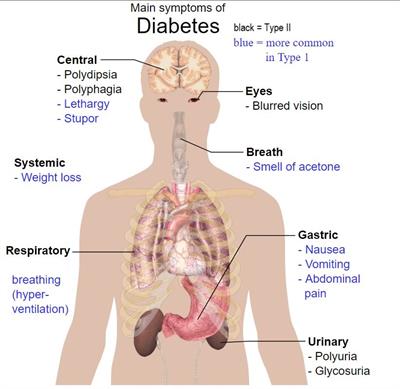
Types of diabetes: Type I is Diabetes mellitus & Type II is Diabetes insipidus
Simmond's Disease
Reference:
https://commons.wikimedia.org/wiki/File:1806_The_Hypothalamus-Pituitary_Complex.jpg
https://upload.wikimedia.org/wikipedia/commons/5/56/Figure_37_05_01ab.jpg
https://upload.wikimedia.org/wikipedia/commons/8/85/Pituitary_Gland.png
https://commons.wikimedia.org/wiki/File:1808_The_Anterior_Pituitary_Complex.jpg
https://en.wikipedia.org/wiki/Gigantism#/media/File:Robert_Wadlow_postcard.jpg
https://en.wikipedia.org/wiki/Chandra_Bahadur_Dangi#/media/File:Chandra_04.jpg
https://upload.wikimedia.org/wikipedia/commons/8/82/201405_pituitary_gland.png
https://en.wikipedia.org/wiki/Sultan_K%C3%B6sen#/media/File:Fingerprint_(4045876833).jpg
https://upload.wikimedia.org/wikipedia/commons/4/47/Acromegaly_hands.JPEG
https://upload.wikimedia.org/wikipedia/commons/thumb/1/10/Browprotrusion.jpg/512px-Browprotrusion.jpg
https://upload.wikimedia.org/wikipedia/commons/thumb/1/1a/Man_showing_the_characteristic_appearances_of_acromegaly_Wellcome_L0062529.jpg/512px-Man_showing_the_characteristic_appearances_of_acromegaly_Wellcome_L0062529.jpg
https://upload.wikimedia.org/wikipedia/commons/thumb/9/9e/Hands_and_feet_of_a_patient_suffering_from_acromegaly_Wellcome_L0061368.jpg/512px-Hands_and_feet_of_a_patient_suffering_from_acromegaly_Wellcome_L0061368.jpg
https://upload.wikimedia.org/wikipedia/commons/thumb/f/f5/Male_patient_suffering_from_acromegaly_Wellcome_L0061294.jpg/512px-Male_patient_suffering_from_acromegaly_Wellcome_L0061294.jpg
https://upload.wikimedia.org/wikipedia/commons/5/56/Figure_37_05_01ab.jpg
https://upload.wikimedia.org/wikipedia/commons/8/85/Pituitary_Gland.png
https://commons.wikimedia.org/wiki/File:1808_The_Anterior_Pituitary_Complex.jpg
https://en.wikipedia.org/wiki/Gigantism#/media/File:Robert_Wadlow_postcard.jpg
https://en.wikipedia.org/wiki/Chandra_Bahadur_Dangi#/media/File:Chandra_04.jpg
https://upload.wikimedia.org/wikipedia/commons/8/82/201405_pituitary_gland.png
https://en.wikipedia.org/wiki/Sultan_K%C3%B6sen#/media/File:Fingerprint_(4045876833).jpg
https://upload.wikimedia.org/wikipedia/commons/4/47/Acromegaly_hands.JPEG
https://upload.wikimedia.org/wikipedia/commons/thumb/1/10/Browprotrusion.jpg/512px-Browprotrusion.jpg
https://upload.wikimedia.org/wikipedia/commons/thumb/1/1a/Man_showing_the_characteristic_appearances_of_acromegaly_Wellcome_L0062529.jpg/512px-Man_showing_the_characteristic_appearances_of_acromegaly_Wellcome_L0062529.jpg
https://upload.wikimedia.org/wikipedia/commons/thumb/9/9e/Hands_and_feet_of_a_patient_suffering_from_acromegaly_Wellcome_L0061368.jpg/512px-Hands_and_feet_of_a_patient_suffering_from_acromegaly_Wellcome_L0061368.jpg
https://upload.wikimedia.org/wikipedia/commons/thumb/f/f5/Male_patient_suffering_from_acromegaly_Wellcome_L0061294.jpg/512px-Male_patient_suffering_from_acromegaly_Wellcome_L0061294.jpg
https://commons.wikimedia.org/wiki/File:1807_The_Posterior_Pituitary_Complex.jpg
https://commons.wikimedia.org/wiki/File:Main_symptoms_of_diabetes_hi.svg#/media/File:Main_symptoms_of_diabetes.svg
